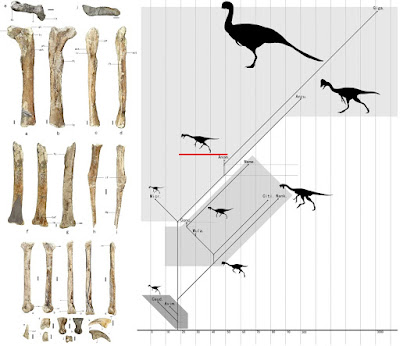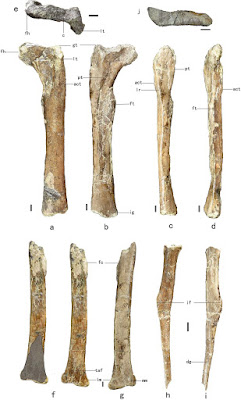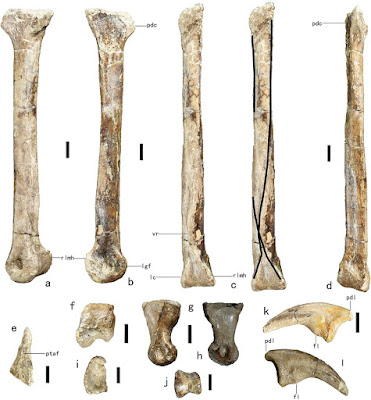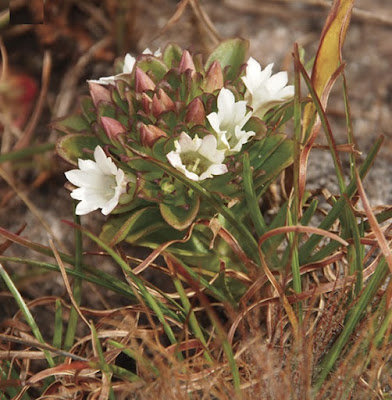[Most Recent Entries] [Calendar View]
Tuesday, June 12th, 2018
| Time | Event | ||
| 2:05a | [Paleontology • 2018] Anomalipes zhaoi • A New Caenagnathid Dinosaur from the Upper Cretaceous Wangshi Group of Shandong, China, with Comments on Size Variation Among Oviraptorosaurs
Abstract The bone-beds of the Upper Cretaceous Wangshi Group in Zhucheng, Shandong, China are rich in fossil remains of the gigantic hadrosaurid Shantungosaurus. Here we report a new oviraptorosaur, Anomalipes zhaoi gen. et sp. nov., based on a recently collected specimen comprising a partial left hindlimb from the Kugou Locality in Zhucheng. This specimen’s systematic position was assessed by three numerical cladistic analyses based on recently published theropod phylogenetic datasets, with the inclusion of several new characters. Anomalipes zhaoi differs from other known caenagnathids in having a unique combination of features: femoral head anteroposteriorly narrow and with significant posterior orientation; accessory trochanter low and confluent with lesser trochanter; lateral ridge present on femoral lateral surface; weak fourth trochanter present; metatarsal III with triangular proximal articular surface, prominent anterior flange near proximal end, highly asymmetrical hemicondyles, and longitudinal groove on distal articular surface; and ungual of pedal digit II with lateral collateral groove deeper and more dorsally located than medial groove. The holotype of Anomalipes zhaoi is smaller than is typical for Caenagnathidae but larger than is typical for the other major oviraptorosaurian subclade, Oviraptoridae. Size comparisons among oviraptorisaurians show that the Caenagnathidae vary much more widely in size than the Oviraptoridae. Systematic palaeontology Theropoda Marsh 1881 Oviraptorosauria Barsbold 1976 Caenagnathidae Sternberg 1940 Anomalipes zhaoi gen.et sp. nov Etymology: Generic name is a combination of the Latin “Anomalus” and “pes”, referring to the unusual shape of the foot. Specific name is in honour of Xijin Zhao, a Chinese palaeontologist who has made great contributions to research on Zhucheng dinosaur fossils. Holotype: ZCDM V0020 (Zhucheng Dinosaur Museum, Zhucheng, Shandong, China), an incomplete left hindlimb, including the left femur missing the distal end, the left tibia missing the proximal end, the left fibula missing the distal and proximal ends, a complete metatarsal III and two pedal phalanges. Although these bones are disarticulated, they are inferred to be derived from a single theropod individual given that 1) they were preserved in a small area of less than 0.3 square metres within a Shantungosaurus bonebed; and 2) no other theropod skeletal elements are preserved nearby. Locality and horizon: Kugou, Zhucheng City, Shandong Province, China. Upper Cretaceous Wangshi Group. Diagnosis: A new caenagnathid with the following unique combination of features: femoral head anteroposteriorly narrow and somewhat deflected posteriorly; accessory trochanter low; lateral ridge present on femoral lateral surface; weak fourth trochanter present; metatarsal III with triangular proximal articular surface, prominent anterior flange near proximal end, medial hemicondyle much narrower than lateral hemicondyle, and longitudinal groove on distal articular surface; and pedal phalanx II-3 with lateral collateral groove deeper and more dorsally located than medial groove. Yilun Yu, Kebai Wang, Shuqing Chen, Corwin Sullivan, Shuo Wang, Peiye Wang and Xing Xu. 2018. A New Caenagnathid Dinosaur from the Upper Cretaceous Wangshi Group of Shandong, China, with Comments on Size Variation Among Oviraptorosaurs. Scientific Reports. volume 8, Article number: 5030. DOI: 10.1038/s41598-018-23252-2 | ||
| 4:06a | [Crustacea • 2018] Species of the Maera-clade collected from Japan. Part 1: Genera Maeropsis Chevreux, 1919 and Orientomaera gen. nov. (Amphipoda: Maeridae)
Abstract The Maera-clade is a group of maerid amphipod genera which has neither a falcate mandibular palp nor medially setose inner plates of maxillae 1 and 2. Two species of Maeropsis Chevreux, 1919 and four species of Orientomaera gen. nov. included in the clade, are described from Japan. Maeropsis okinawensis sp. nov. is described, based on collections from Okinawa Prefecture. It resembles M. cobia Krapp-Schickel, 2009, M. paphavasitae Wongkamhaeng, Coleman & Pholpunthin, 2013, and M. serratipalma (Nagata, 1965). This new species differs from the latter three species in the long uropod 3. Maeropsis serratipalma is redescribed and newly recorded from Kanagawa, Osaka and Wakayama Prefectures. The new genus, Orientomaera, is described and is characterized by the mandibular palp article 1 without a distal tooth and the oblique palm of the gnathopod 2 with many robust setae. Orientomaera comprises four species: Orientomaera brevispina (Kim & Kim, 1991) comb. nov. from Iwate, Fukui, Kyoto and Wakayama Prefectures and Ariake Sea; O. decipiens sp. nov. from Osaka and Wakayama Prefectures; O. obliquua sp. nov. from Osaka and Wakayama Prefectures; O. rotundicoxa sp. nov. from Kanagawa and Wakayama Prefectures. These species can be distinguished from one another by the coxa 1, the gnathopod 2 propodus, the pereopod 6 basis and the telson. Keys to species of Maeropsis and Orientomaera in the world are provided. Keywords: Crustacea, Amphipoda, Maeridae, Maeropsis, Orientomaera, Japan, new genus, new species Hiroyuki Ariyama. 2018. Species of the Maera-clade collected from Japan. Part 1: Genera Maeropsis Chevreux, 1919 and Orientomaera gen. nov. (Crustacea: Amphipoda: Maeridae). Zootaxa. 4433(2); 201–244. DOI: 10.11646/zootaxa.4433.2.1 | ||
| 4:41a | [Botany • 2018] Gentiana laotica • A New Species of Gentianaceae from Laos
ABSTRACT A new species of Gentiana (Gentianaceae), Gentiana laotica Soulad., Tagane & Yahara, from Phou Khao Khouay National Protected Area, Vientiane Province, central Laos, is described. Photographs, vernacular name, DNA barcodes of rbcL, matK and ITS, and preliminary conservation status are provided for the new species. KEYWORDS: flora, Gentianaceae, Laos, Phou Khao Khouay NPA, taxonomy Gentiana laotica Soulad., Tagane & Yahara, sp. nov. Gentiana laotica is similar to G. bokorensis Hul of Cambodia and G. arenicola Kerr of northeastern Thailand in having single erect stem, number of stem leaves increasing toward stem apex and 5-merous flowers, but differs from the formers in having obovateto obovate-oblong leaves (vs narrowly ovate-triangularin G. bokorensis), whitish corolla (blue-purplish) and 5 equal sepals (vs often unequal, 2 small and 3 large) and from the latter in having smaller calyx lobes (4–5 mm long in G. laotica vs 5–7 mm long in G. arenicola), white flowers (vs pale blue), longer corolla lobes (ca 3 mm long vs 1.5 mm long) and smaller anthers (1.2 mm long vs 2 mm long). Vernacular.— Wheed Khao (ຫວິດຂາວ) (suggested here). Etymology.— The specific epithet refers to the country where we collected the plant. Phetlasy Souladeth, Shuichiro Tagane, Akiyo Naiki, Hidetoshi Nagamasu and Tetsukazu Yahara. 2018. Gentiana laotica, A New Species of Gentianaceae from Laos. Thai Forest Bulletin. 46(1); 72-75. DOI 10.20531/tfb.2018.46.1.11 ດອກຫວິດຂາວ, ພືດຊະນິດທີ່ພົບຢູ່ພູເຂົາຄວາຍ, ໂດຍ: ອຈ. ເພັດລາສີ (ຈາກຄະນະວິທະຍາສາດປ່າໄມ້) |
| << Previous Day |
2018/06/12 [Calendar] |
Next Day >> |










